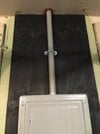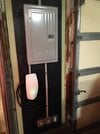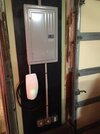I hope to be taking delivery of a Tesla Model Y performance in the coming weeks. During the wait, I have done a lot of research regarding the charging infrastructure and read through the NEMA 14-50 master thread in the Model 3 forums. I have done some electrical work myself and I am starting this thread more to validate my thoughts or have my thoughts critiqued on how the outlet should be installed.
We just recently moved to a new construction townhouse which is pre-wired for EV charging. I just need to install the receptacle and the breaker. The preinstalled box and the circuit breaker are within about 3-4 ft from each other. I just got to removing the circuit breaker panel and the prewired receptacle box and saw that the wiring is aluminum (at least that's what I think it is, the wires inside were silver). This is not what I expected and was expecting it to be copper. Based on my wire gauge measurement, it appears to be 6 awg. I plan to buy a 40A breaker as I am only going to be using the UMC for now with a NEMA 14-50 receptacle. I don't want to get 50A because the UMC does not pull that much current and I don't want to have too much overhead before the breaker trips in case of any issues.
Do you guys think it would be feasible to electrical tape an end of copper Romex 6/3 cable to one end of the existing aluminum wire and pull it through to replace to copper? That way I don't need to open the dry wall to replace the cable. I would also be able to use the Hubbell/Bryant commercial grade receptacle. Or should I just get a Cooper 5754N receptacle which accepts AL wiring? Is there anything else I should watch out for in terms of the AL wiring?
Any advice or suggestions are appreciated.
We just recently moved to a new construction townhouse which is pre-wired for EV charging. I just need to install the receptacle and the breaker. The preinstalled box and the circuit breaker are within about 3-4 ft from each other. I just got to removing the circuit breaker panel and the prewired receptacle box and saw that the wiring is aluminum (at least that's what I think it is, the wires inside were silver). This is not what I expected and was expecting it to be copper. Based on my wire gauge measurement, it appears to be 6 awg. I plan to buy a 40A breaker as I am only going to be using the UMC for now with a NEMA 14-50 receptacle. I don't want to get 50A because the UMC does not pull that much current and I don't want to have too much overhead before the breaker trips in case of any issues.
Do you guys think it would be feasible to electrical tape an end of copper Romex 6/3 cable to one end of the existing aluminum wire and pull it through to replace to copper? That way I don't need to open the dry wall to replace the cable. I would also be able to use the Hubbell/Bryant commercial grade receptacle. Or should I just get a Cooper 5754N receptacle which accepts AL wiring? Is there anything else I should watch out for in terms of the AL wiring?
Any advice or suggestions are appreciated.





